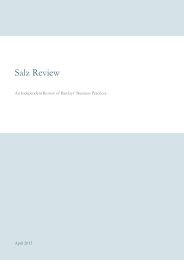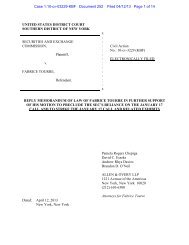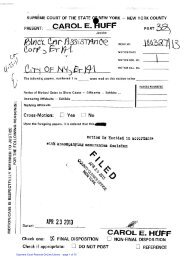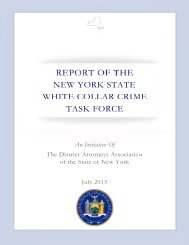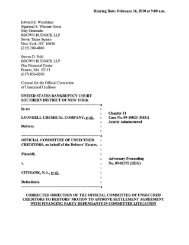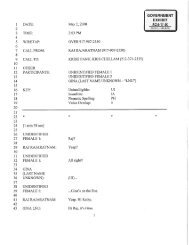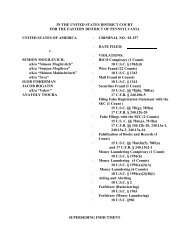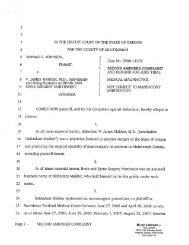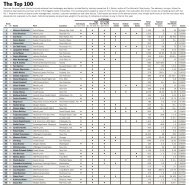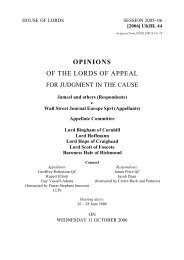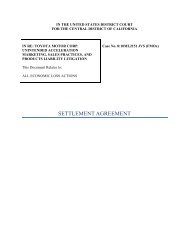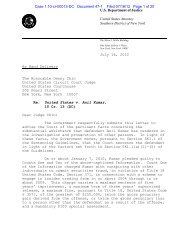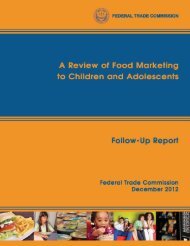Excerpts from the depositions - Wall Street Journal
Excerpts from the depositions - Wall Street Journal
Excerpts from the depositions - Wall Street Journal
You also want an ePaper? Increase the reach of your titles
YUMPU automatically turns print PDFs into web optimized ePapers that Google loves.
Case 2:11-cv-10549-MRP-MAN Document 254-1 Filed 03/28/13 Page 8 of 35 Page ID<br />
#:16597<br />
Swift testified that had AIG been transferring fraud claims to ML II, he would have wanted to<br />
present that to <strong>the</strong> state insurance regulators.<br />
• “Q. What was your role in making presentations to insurance regulators about <strong>the</strong> ML II<br />
transaction? A. Yeah, I was <strong>the</strong> lead spokesperson for AIG’s Life and P[&]C<br />
companies on <strong>the</strong> securities lending matter. Q. And what type of oversight, what type<br />
of information did <strong>the</strong> regulators want to hear <strong>from</strong> you as <strong>the</strong> principal presenter?<br />
[Objection ] A. They want―<strong>the</strong>y wanted, and expected, transparency on anything<br />
significant.” 99:13–100:2.<br />
• “Q. [Discussing presentation to insurance regulators] Is <strong>the</strong>re any reference to <strong>the</strong><br />
assignment of fraud claims to ML II in Exhibit 77? A. No. Q. In making your<br />
presentations to insurance regulators, how did you describe <strong>the</strong> assets that AIG was<br />
selling to ML II? A. Throughout <strong>the</strong> various pages in here, you can see that we<br />
were―we―we were referring to <strong>the</strong> assets, . . . ei<strong>the</strong>r as <strong>the</strong> RMBS assets or <strong>the</strong><br />
non-RMBS assets. . . . [T]he RMBS assets, as it related to <strong>the</strong> ML II transaction,<br />
were described as residential mortgage-backed securities. Q. And did you say<br />
anything to <strong>the</strong> regulators that might suggest fraud claims were being assigned? A. No.”<br />
101:3–102:2.<br />
• “Q. If you had believed that fraud claims were assigned to ML II, what, if anything,<br />
would you have done differently in your presentations to insurance regulators? A. At<br />
minimum, I probably would have had a bullet point just talking through it as―as a<br />
deal point. Q. Why? A. I think, again, if―if you really understand <strong>the</strong> nature of <strong>the</strong><br />
securities lending pool, <strong>the</strong>se were <strong>the</strong> assets and obligations of <strong>the</strong> underlying<br />
insurance company’s balance sheets. And if AIG gave up that right and obligation,<br />
<strong>the</strong> insurance commissioners will want to know about a future monetizable asset, or<br />
future recovery that was also, you know, given up. So, anyway, it would have just<br />
been a significant part of <strong>the</strong> overall transaction we would have talked about.”<br />
102:3–23.<br />
Swift testified that ML II was intended to stabilize AIG while ensuring <strong>the</strong> FRBNY would be<br />
repaid.<br />
• “Q. In structuring this Maiden Lane II transaction, what was your understanding of <strong>the</strong><br />
objective as to AIG going forward? [Objection] A. I mean, <strong>the</strong> objective of AIG was<br />
to stabilize, continue to stabilize, you know, <strong>the</strong> organization with a solution to a<br />
program that―that created large credit losses and some inherent volatility in its<br />
equity position. Q. So, to put it in more simple terms: Was <strong>the</strong> transaction part of a<br />
solution to help AIG recover <strong>from</strong> <strong>the</strong> financial crisis? A. I believe so.” 120:14–121:4.<br />
• “A. The Fed made it very clear that it was a lender. It was intent on having its loan<br />
repaid, and it used BlackRock and us to give <strong>the</strong>m comfort that, under various<br />
economic conditions and scenarios, <strong>the</strong>ir loan would be repaid. They made it very<br />
clear that <strong>the</strong>y had never had a loss on a loan <strong>the</strong>y made, and <strong>the</strong>y never intend to<br />
have a loss on a loan that <strong>the</strong>y made.” 82:7–16.<br />
• “A. That was <strong>the</strong> Fed’s primary objective, was to always be viewed as <strong>the</strong> lender,<br />
and <strong>the</strong>y never were going to be allowed/permitted to incur a loss. Q. Did you<br />
understand why this transaction resulted in a very low likelihood of failing to repay <strong>the</strong><br />
EXHIBIT 1<br />
7



